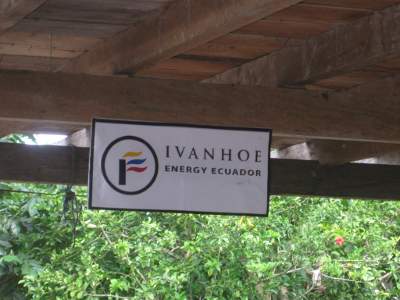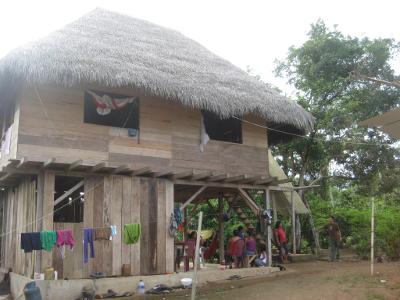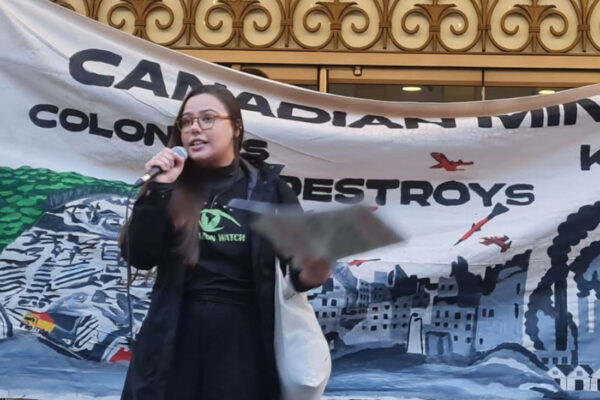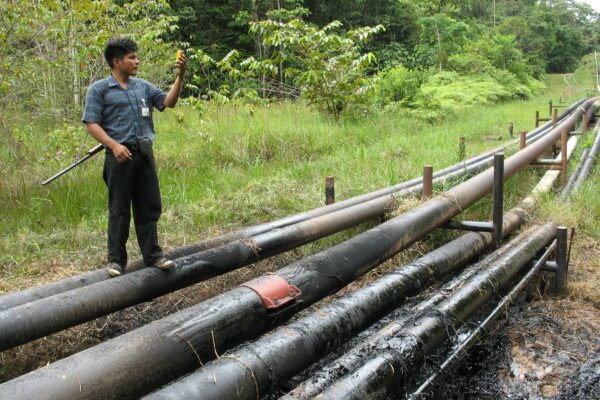
Ivanhoe’s most recent press release on the progress of the Pungarayacu project, posted March 16, 2010, contradicts the truth from the ground about what is happening with the project and glorifies the HTL drilling technology as having “environmental advantages.”
Ivanhoe states that it is “seeking approval for an additional 20 wells” without specifying where or when these additional wells would go. The contract gives Ivanhoe permission for four wells within the first three years of the contract. Adding wells would require the company to obtain a new environmental license and a new environmental impact study. This is the second press release since January in which Ivanhoe has said they are looking to implement an additional 20 wells, yet there is no knowledge in the ministries of environment in Tena or Quito to confirm this claim. Carlos Espinoza, head engineer for Ivanhoe Energy Ecuador, made a public statement at a meeting in Puerto Napo on March 17, about the 20 additional wells without giving specific information.
According to Ivanhoe’s contract, the first three years are designated to investigate the oil field using only three wells. The second phase is another three-year pilot phase in which Ivanhoe plans to build the HTL plant. The third phase is 24 years of extracting oil from established sites and further exploring for well sites.
Construction has begun on the second well site in the community of Ceibo, near the community of Yutzupino both of which are just outside of Puerto Napo. The home in the photo lies on the property Ivanhoe bought for the second well. Five families will be removed from their homes, which lie on the property Ivanhoe bought for the drilling platform. The company has said they’ll relocate the families, though Ivanhoe representatives have failed to show up to negotiate with the families multiple times.
“They talk and talk but they don’t keep their word. We want them to be a model company and show that they’ll provide us with the services we need,” said one of the homeowners who will lose his home to the Ivanhoe project.
The families waited for Espinoza to show up on March 17, the day he visited Napo, but he never came. This led all five families to travel to Quito to seek out compensation from Ivanhoe. They were told the negotiations were pending until Ivanhoe’s lawsuit against a Yutzupino Kichwa family was settled.

Community relations between the company and local inhabitants have proven to be volatile. Communities have an increasingly negative impression of Ivanhoe, as company representatives have a reputation for failing to show up for meetings with local government officials, such as the mayor of Tena, or communities. The press release states, “Ivanhoe Energy Ecuador is working in close cooperation with local communities, local government and the Ecuadorian federal government to ensure that its development plan is approved and complies with all environmental regulations.” In a meeting in Napo on March 11, townspeople of Napo voted during the meeting to suspend the session with Ivanhoe because Ivanhoe executive Carlos Espinoza failed to be present as promised. Community members highly anticipated his arrival to clarify details about the project, jobs and compensation Ivanhoe would offer to those affected by the project. This was not the first time an Ivanhoe representative failed to appear when promised to the people.
During a visit to Cotundo, where the first Ivanhoe well is already drilling for oil, a local said, “The company said, ‘although you don’t want us to enter, we’re going to come either way.” Inhabitants of Cotundo and Nueva Esperanza, towns closest to the well, said that the company entered without consulting with the communities. Rather, they only negotiated with the landowners.
In a community meeting in Yutzupino on March 5, community members complained that they hadn’t been educated on what HTL technology entails and wanted to know Ivanhoe’s specific plans for the area. To proceed fairly and legally, Ivanhoe must increase transparency and uphold their word to communicate with communities. Both in Cotundo and Napo there is great frustration on the part of the communities that Ivanhoe simply has not socialized the project as promised.
In the final paragraph of the press release Ivanhoe defends its HTL technology for its “environmental advantages.” The Steam Assisted Gravity Drainage (SAGD) process, which uses steam injections to turn the oil from heavy to light below the surface, requires between 2 and 4 barrels of water for every barrel of recovered oil. Oil sands account for 65% of water withdrawn from the Athabasca River in Canada, while Venezuela’s oil company Petrocedeño has taken measures to minimize water production in the Faja heavy oil region. In populated regions like Napo province, extraction and drainage of natural sources of water poses a major threat to the way of life of its inhabitants.
In addition, industrial chemicals are injected with the steam, making it virtually impossible to return the water to the river. Though the water can be recycled if treated, the Environmental Impact Assessment (EIA) states that all produced water will be “segregated, stored in tanks or on site, treated, and disposed of at an official site,” meaning the water will not return to its natural source.
The rivers are an essential part of eco-tourism in the region. Even the smallest amount of contaminants in the river could completely alter the way of life. The EIA states that the risk of water contamination is “irrelevant” to the project, despite the fact that the study identifies water as one of the most “vulnerable elements” of industrial activity. Roads, infrastructure and construction materials necessary for the project all impact the ecosystems and the communities near the well.
* This update was produced by Emily Howland and local contributors
Please show your support for indigenous communities in Napo province by signing a letter to government officials.













